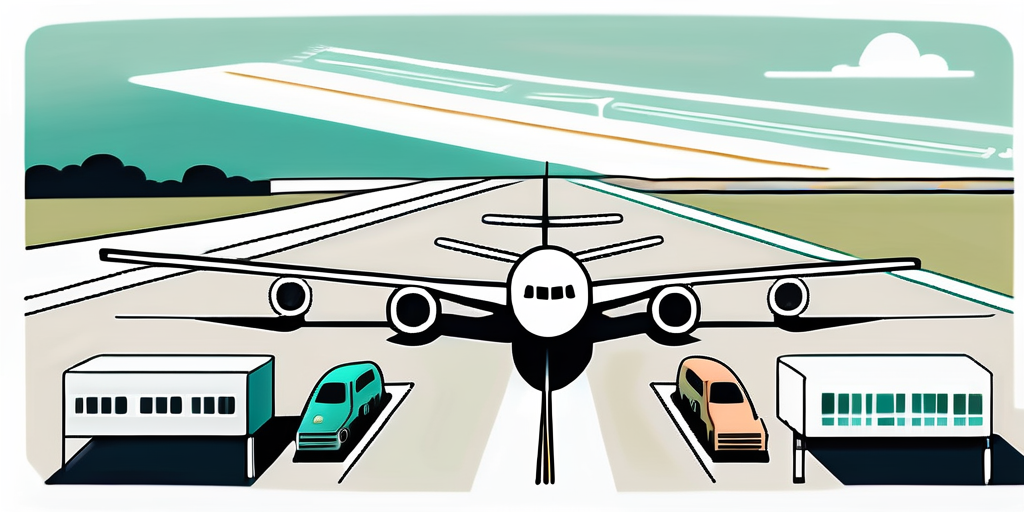The Ultimate Guide to Connecting Flights with Different Airlines
Navigating connecting flights with different airlines? Learn about interlining, baggage transfers for a stress-free trip.
Connecting flights can be a convenient option when traveling to your destination. It allows you to reach multiple locations without the hassle of booking separate tickets and managing your own transfers. In this guide, we will explore the basics of connecting flights and provide you with essential tips to ensure a smooth and stress-free journey.
Understanding the Basics of Connecting Flights
Before we dive into the details, let's clarify what exactly a connecting flight is. A connecting flight is a journey where you have a layover at an intermediary airport before reaching your final destination. Instead of flying directly from point A to point B, you will have to transfer from one aircraft to another during your journey.

What is a Connecting Flight?
At its core, a connecting flight allows airlines to efficiently transport passengers between destinations that are not directly connected by non-stop flights. For example, if you are traveling from New York to Sydney, you may need to connect in Los Angeles or another hub city before continuing your journey. While it may require additional time and effort, connecting flights offer more flexibility and a wider range of destinations.
Benefits of Choosing Connecting Flights
Choosing connecting flights over non-stop flights can have several advantages. Firstly, it expands your travel options, allowing you to reach destinations that are not directly accessible. Additionally, connecting flights often provide lower fares compared to non-stop flights, making it an attractive option for budget-conscious travelers. Lastly, you may have the opportunity to explore or spend time in the connecting city, adding an extra dimension to your trip.
Let's delve deeper into the benefits of choosing connecting flights. One major advantage is the opportunity to break up a long journey into smaller, more manageable segments. This can be particularly beneficial for those who are not fond of long-haul flights or have specific travel preferences. For example, if you are traveling from London to Tokyo, you could choose a connecting flight with a layover in Dubai. This not only allows you to stretch your legs and refresh yourself during the layover but also provides a chance to experience the vibrant city of Dubai, even if it's just for a few hours.
Additionally, connecting flights can be a great way to explore multiple destinations within a single trip. Imagine you are planning a vacation to Southeast Asia. Instead of flying directly to your final destination, you could opt for a connecting flight that allows you to visit multiple countries along the way. For instance, you could choose a flight that connects in Singapore, giving you the chance to explore the bustling city-state before continuing your journey to Bali or Thailand.
Furthermore, connecting flights often offer more flexibility when it comes to scheduling. Non-stop flights may have limited departure times, whereas connecting flights provide a wider range of options. This can be advantageous if you have specific time constraints or prefer to travel at a certain time of day. With connecting flights, you have the freedom to choose a departure time that suits your needs, allowing for a more personalized travel experience.
Navigating Different Airlines for Connections
When booking a connecting flight, you may find yourself traveling with different airlines. It is essential to familiarize yourself with each airline's connection policies to ensure a seamless travel experience.
But let's dive deeper into the world of airline connections, shall we? Let's explore the major airlines and their connection policies, as well as what to expect when booking with budget airlines.
Major Airlines and Their Connection Policies
Major airlines typically have partnership agreements with other carriers, allowing them to offer connecting flights through their extensive network. These partnerships often go beyond just convenience and can provide a range of benefits to passengers. For instance, shared ticketing means that you can purchase a single ticket for your entire journey, even if it involves multiple airlines. This eliminates the hassle of having to purchase separate tickets and allows for smoother transitions between flights.
Additionally, major airlines with partnership agreements often offer baggage transfer services. This means that your checked luggage can be automatically transferred to your final destination, even if you have to switch airlines during your journey. This not only saves you from the hassle of having to collect and recheck your bags but also reduces the risk of lost or mishandled luggage.
Furthermore, these partnerships can provide assistance in case of delays or missed connections. If your first flight is delayed and you're at risk of missing your connecting flight, the airlines will work together to find a solution. This could involve rebooking you on the next available flight or providing accommodation if necessary. The goal is to minimize any inconvenience caused by unexpected disruptions and ensure that you reach your destination as smoothly as possible.
Always check the airline's website or contact their customer service to understand their specific connection policies. Each airline may have its own unique set of rules and procedures, so it's crucial to be well-informed before embarking on your journey.
Budget Airlines: What to Expect
On the other hand, budget airlines may operate independently and may not have partnerships with other carriers. This means that when booking connecting flights with budget airlines, you need to take extra precautions to ensure a seamless travel experience.
First and foremost, it's important to allow ample time for transfers when booking with budget airlines. Unlike major airlines with coordinated schedules, budget airlines may have limited flight options and fewer connections. This means that you may need to plan for longer layovers to ensure that you have enough time to make your next flight.
Additionally, budget airlines often have stricter policies when it comes to luggage and services. They may charge additional fees for checked bags, carry-on bags, and even printing your boarding pass at the airport. It's crucial to familiarize yourself with these policies and factor in any extra costs when budgeting for your trip.
While budget airlines may not offer the same level of convenience and assistance as major airlines, they can still provide affordable travel options. By being well-prepared and understanding their policies, you can make the most out of your journey while keeping your wallet happy.
Booking Your Connecting Flights
Booking connecting flights can be done through various channels, including online booking platforms or travel agencies. Each method has its own advantages and considerations.
Online Booking Tips
When booking your connecting flights online, make sure to carefully select the departure and arrival times of each segment. Leave enough time between flights to account for potential delays and allow sufficient time for transfers. Additionally, consider booking your flights with the same airline or their partner airlines to take advantage of their connection services.
One important factor to consider when booking your connecting flights online is the layover duration. While it may be tempting to choose the shortest layover possible to minimize travel time, it's crucial to strike a balance. Opting for a longer layover can provide a buffer in case of unexpected delays, reducing the risk of missing your connecting flight. It also allows you to explore the connecting airport or even the city if you have enough time.
Travel Agency vs. Self-Booking
Alternatively, you can opt to book your connecting flights through a travel agency. Travel agencies can offer expert advice, bundle deals, and personalized assistance. However, keep in mind that you may have limited flexibility in choosing specific airlines, flights, or connecting airports.
One advantage of booking through a travel agency is the convenience of having a dedicated professional handle all the details for you. They can help you navigate complex itineraries, find the best deals, and provide valuable insights based on their industry knowledge. Additionally, travel agencies often have access to exclusive offers and discounts that may not be available through online booking platforms.
On the other hand, self-booking gives you the freedom to customize your itinerary according to your preferences. You have the flexibility to choose the airlines, flights, and layover durations that suit your needs. This can be particularly beneficial if you have specific airline loyalty programs or if you prefer certain airports for connections.
Managing Layovers and Transit Times
A well-managed layover can significantly impact your overall travel experience. Here are some considerations when planning your layovers and transit times.

Ideal Layover Duration
The ideal layover duration depends on multiple factors, such as the airport size, your familiarity with the airport, and the potential need for immigration or security checks. As a general guideline, allow at least 1 to 2 hours for domestic connections and 2 to 3 hours for international connections to mitigate the risk of missing your second flight.
Dealing with Unexpected Delays
Unfortunately, unexpected delays are a reality of air travel. In the event of delays, airlines may provide rebooking options or assistance to get you to your final destination. Stay in close communication with airline staff, monitor flight updates, and consider travel insurance to mitigate any delays' financial impact.
Essential Tips for Smooth Transfers
As you prepare for your connecting flights, consider these essential tips to enhance your travel experience and minimize any potential hiccups.

Packing for Connecting Flights
When packing for connecting flights, consider the applicable baggage restrictions and security protocols for each airline you will be traveling with. Pack essential items, such as medications or valuables, in your carry-on luggage to ensure they remain with you at all times.
Navigating Airport Terminals Efficiently
Airports can be busy and overwhelming, especially during peak travel seasons. To navigate airport terminals efficiently, familiarize yourself with the airport layout, check for any terminal changes, and follow signage or ask airport staff for assistance if needed. Be mindful of time and look for faster security and immigration lanes when available.
By understanding the basics of connecting flights, navigating different airlines, and following essential tips, you can ensure a smooth and enjoyable journey to your destination. Embrace the convenience and opportunities presented by connecting flights, and make the most out of your travel experience.
Get the Compensation You Deserve with ClaimCompass
If your journey with connecting flights ever goes awry due to delays, cancellations, or overbookings, remember that ClaimCompass is here to help you claim up to 600€ in compensation. Our expertise in EU Regulation 261/2004 and our commitment to air passenger rights in Europe means we'll handle your claim from start to finish – submitting it, communicating with the airline, and even taking legal action if necessary. Use our compensation calculator to check your eligibility for free, and let us take care of the rest. Remember, there's no fee unless we succeed, so you have nothing to lose by submitting your claim with us.
